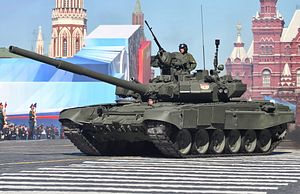Thailand announced this week that it is in the process of setting up a procurement committee to evaluate Chinese and Russian tank models in order to select a new main battle tank (MBT) for service in the Royal Thai Army (RTA), the Bangkok Post reports.
Earlier in the week, the Thai military had initially denied media reports that it is considering purchasing a Russian-made tank, the T-90(M)S MBT. Now, according to Thailand’s ministry of defense, the procurement committee is purportedly considering two different Chinese and Russian MBT models.
Royal Thai Army spokesperson Colonel Winthai Suvaree emphasized that the military will make a decision based on cost-effectiveness. “The Army’s aware it’s taxpayers money,” he said. He did not go into details as to when a selection will be made, nor offer a price estimate.
Thailand’s defense minister, Prawit Wongsuwon, will visit Russia in late February and inspect a T-90(M)S model, whereas RTA chief, General Thirachai Nakwanich, visited China in late January to inspect the Chinese MBT3000 or VT-4 model. A Thai delegation visited Russian main battle tank manufacturer Uralvagonzavod in late December 2015 and expressed interest in both the T-90S and the T-14 Armata MBT.
Both the MBT3000 and T-90(M)S are based on the Soviet-era T-72 tank design and armed with a 125-mm smoothbore gun as their main weapon system. Both tanks are also capable of firing anti-tank missiles, although China’s tank maker Norinco claims that the MBT3000 has superior fire-control systems than any Russian-made tank, including the T-14 Armata. In addition, both tanks are ready for serial-production.
As I reported in early January (See: “Will Thailand Buy Russian T-90 Tanks?”):
In 2011, Thailand placed a $240 million order for the purchase of 49 Ukrainian-made T-84 ‘Oplot-M’ MBTs plus a number of support vehicles with Ukrspetsexport, a Ukrainian state-owned defense contractor. Yet, by the end of 2015, only ten tanks had been delivered to the Royal Thai Army, causing concern over future delays among high-ranking officers in the Royal Thai Army.
Five additional tanks are slated for delivery in early 2016, according Ukrspetsexport, although sources say that Bangkok might opt out of the contract due to the delays altogether. (Thailand was originally supposed to receive 20 T-84 tanks in 2015.)
The exact number of MBTs that Royal Thai Army requires is unknown, although there have been reports that Thailand plans to purchase around 200 new MBTs for its armored formations over the next couple of years.
From 1992 to 2013, Russia’s defense industry sold 1,297 MBTs, whereas Chinese tank makers exported a total of 461 MBTs, according to data from the United Nations’ Register of Conventional Arms. Competition between the two countries for market share in the developing world will be fierce.

































